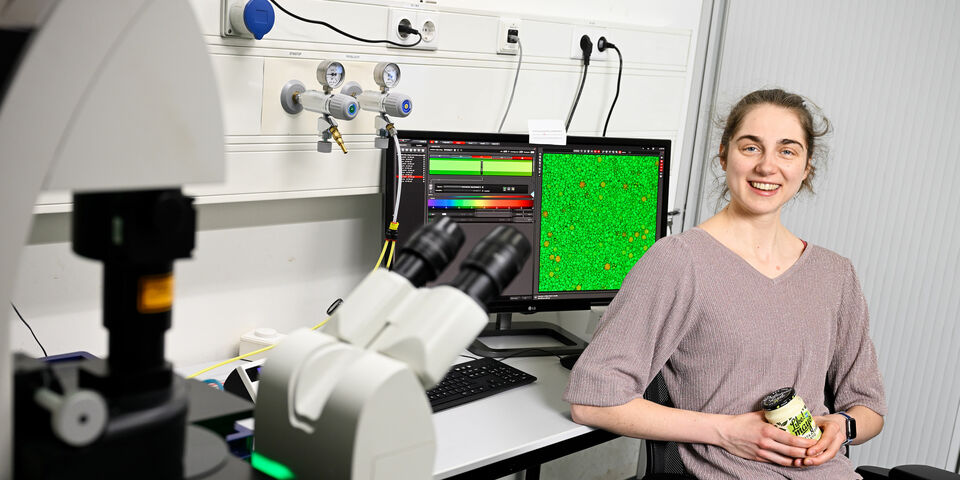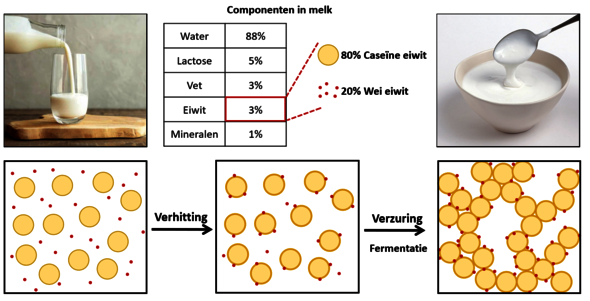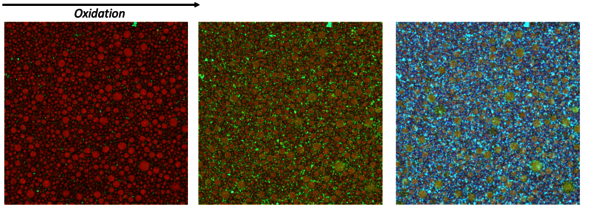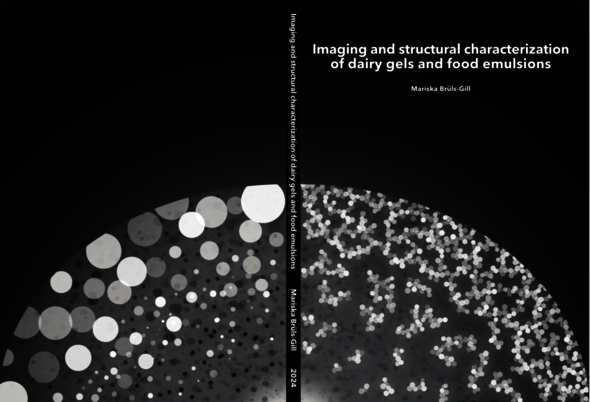Home Stretch | Food under the microscope
Never before has yogurt been studied in such minute detail. TU/e chemist Mariska Brüls-Gill used high-tech microscopy to analyze the transition from milk to thick yogurt. She also investigated which vegetable proteins to use for a good vegan mayonnaise. Because by making the microstructure of food visible, you can optimize food products: make them healthier, improve their structure or extend their shelf life, for example. On Tuesday, March 26, she will defend her dissertation at the Department of Chemical Engineering and Chemistry.
She is a practically-minded woman, and the fact that she loves cooking also benefited her research, laughs Mariska Brüls-Gill. “By now, I could make yogurt in my sleep. I’ve had plenty of experience making yogurt for my experiments: heat milk, add bacteria to acidify it, keep it warm and wait. It’s amazing that we can now observe on a microscopic level what happens in the sour milk.”
Brüls and two fellow PhD candidates have spent the past few years working with Wageningen University & Research (WUR) as well as various food companies such as Unilever and DSM in order to find out how to improve certain foods based on their microstructure. “Proper nutrition is very important. And food products can be improved on a number of fronts. For example, by making small adjustments you can make the product healthier, or tastier: for example through enhancing the crispiness or smoothness. But by changing certain properties, we can also improve its shelf life, thereby reducing food waste.”
Brüls-Gill’s plan was to spend two years in Eindhoven analyzing yogurt and then “move on to mayonnaise” in Wageningen, where she would spend another two years doing research. But research does not always go according to plan, explains Brüls-Gill. “The yogurt research took longer than expected. But we did manage to refine a technique that companies can use to quickly take a look at their yogurt structure. And that’s very important for innovative product development.”
Globules in the yogurt
Back to the beginning. Brüls explains what the yogurt we gobble down with our muesli in the morning, or for dessert in the evening, looks like in detail. “Milk and yogurt have more or less the same composition, but they’re still very different. Yogurt is much more acidic and thicker than milk. This is because of its microstructure. The fats in milk are packed in tiny fat globules, the proteins – mainly casein proteins – form micelles. These are complex structures that, on the outside, do well in an aqueous environment, and on the inside, have a water-repellent part. When you ferment milk by adding lactic acid bacteria, it becomes more acidic. This causes the casein micelles to clump together, with the fat globules in between. And that globule network is what creates the thick structure. But what exactly does that network formation look like in detail? And what aspects influence the clumping process? What makes yogurt even tastier and healthier?”
Plenty of questions, but the problem lay in the technical approach. Because the casein micelles are so small that you cannot make out the individual proteins under a normal microscope. So Brüls-Gill set out to find a technique that would allow her to see the milk proteins in their natural, aqueous solution. She turned to super-resolution microscopy, using techniques that had never been applied to yogurt before. STED, PALM and PAINT are acronyms that come up frequently in her story, high-tech methods that she adapted to her research question. After many trials and errors with mini cups of yogurt-in-the-making, she was able to distinguish different types of milk protein in the yogurt. To get a real-time look at how milk proteins find each other and form a network, she used the more “standard” confocal microscopy. “And then we could really get to work. We studied different mixes of bacteria, and saw clear differences in the microstructure of the yogurts. We also found that sugars made by certain bacterial cultures can very strongly affect yogurt structure. This is especially important for set yogurt, which is not stirred like pourable yogurt. Ideally, you want a nice thick yogurt without any liquid on top.”
Plant-based breakthrough
Next up, the mayonnaise. Mayonnaise is made by thoroughly mixing a large amount of oil with a little vinegar or lemon juice and egg yolks, Brüls-Gill explains. “This creates many tiny fat globules surrounded by a thin layer of watery liquid. Egg yolk allows for a firm emulsion, so you don’t end up with two separate layers – oil and water. Together with our cooperation partner Unilever, we’re looking into which plant-based substitute would yield an equally satisfactory result. Also, with the large amount of unsaturated fatty acids, there is a risk of rancidity due to rapid oxidation, how does that affect vegan mayonnaise?” Using a special luminescent molecule that changes color when the environment oxidizes, Brüls-Gill was able to study the different types of mayonnaise under the microscope. And that had never been done for plant-based mayonnaise before. “When you use soy or pea protein, you will see that the fat globules are larger than those in standard mayonnaise. Egg yolk is a perfect emulsifier, we have yet to figure out how to achieve the same microstructure in vegan mayonnaise. But one very surprising observation was that vegetable proteins slow down the oxidation process. That, in turn, is something we can learn from for the optimization of standard mayonnaise. A fine case of cross-pollination.”
When you want to optimize food products, making the microstructure visible is essential, emphasizes Brüls-Gill once again. Thanks to her research, new techniques have been added to the toolbox. But as important as “molecular gastronomy” is to her research, when she is in the kitchen at home – and especially now that she has gained an entire Indian family, including their food culture, after getting married – she still prefers cooking by feel, she concludes with a smile.
PhD in the Picture
What is that on the cover of your dissertation?
“Yogurt on the front, mayonnaise on the back. And although the two microstructures are very different, my research was still primarily about globules.”
You’re at a birthday party. How do you explain your research in one sentence?
“I study the internal structure of our food in order to learn how to improve food products.”
How do you blow off steam outside of your research?
“Climbing and clambering, preferably at the survival club I’m a member of. I love being physically active like that. And camping in nature together with friends. Without the survival element, though.”
What tip would you have liked to receive as a beginning PhD candidate?
“Invest enough time in setting up your research. Think before you act. Looking back, I’d have liked to approach some experiments in a different way.”
What is your next step?
“I’d like to start working in industry, doing applied research at an R&D department. In secondary school, my General Sciences teacher planted this seed. How can you use science to create new products? This sparked my interest and it is thanks to her that I was able to write my thesis. And the best part: she’ll be in the front row during my defense!”





Discussion